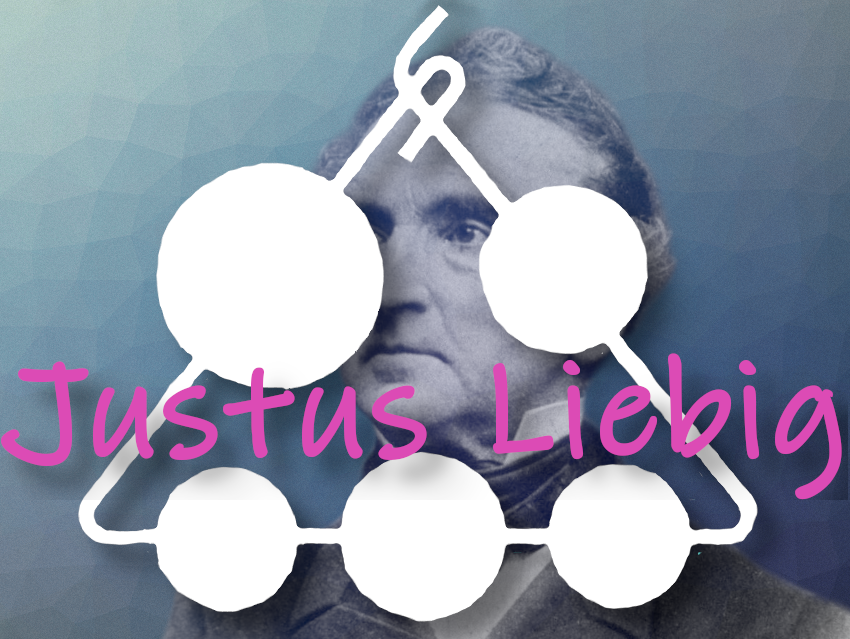Justus von Liebig (1803 – 1873), a distinguished chemist of the 19th century, had numerous students throughout his career. Alexander von Humboldt was enthusiastic about the young Liebig and helped the only 21-year-old to a professorship in Gießen, Germany. Liebig served as a professor in Gießen from 1824 to 1852 before relocating to Munich. During his time at the University of Gießen, Liebig revolutionized the teaching of chemistry by implementing a curriculum enriched with numerous experiments and became world famous.
|
“From 1835 onward, a steadily growing number of students came to study with Liebig: there were about 700 in all, plus 30 visiting scholars. The proportion of foreigners was a unique feature of Gießen at the time: 83 of Liebig’s students came from Great Britain, followed by 38 Swiss, 27 French, 16 Americans, and 13 Russians, as well as a few Italians and Danes, one Spaniard and one Mexican. Liebig’s connections with England were particularly close, and he visited the country three times, where he established close contacts with industry and agriculture. In 1845, the Royal College of Chemistry was founded in London on the Gießen model, and by 1865 almost all newly created professorships in chemistry at British universities, colleges, and teaching hospitals were filled by Liebig students.” said Professor Christoph Meinel, Chairman of the GDCh Commission Historical Sites of Chemistry, on the occasion of the presentation of the EuChemS Historical Landmarks Award to the Justus Liebig Laboratory in Gießen. |
Which of the following researchers were students of Liebig, and which ones were not?
 August Wilhelm Hofmann
August Wilhelm Hofmann
See answer
August Wilhelm von Hofmann studied under Justus Liebig from 1836 to 1845, obtained his doctorate, and subsequently became Liebig’s assistant after habilitation. Later he went to the UK. Hofmann was heavily influenced by Liebig and followed his example in fostering a chemistry education focusing on experimental work and industrial applications.
 Friedrich Wöhler
Friedrich Wöhler
See answer
Justus Liebig and Friedrich Wöhler (1800 – 1882) were friends who helped establish organic chemistry as a systematic field of study.
 August Kekulé
August Kekulé
See answer
August Kekulé (1829 – 1896), a leading figure in theoretical chemistry widely recognized as the founder of the theory of chemical structure, notably the Kekulé structure of benzene, studied under Liebig, received his doctorate in 1852, and later became a professor at the University of Bonn, Germany.
 Alexander von Humboldt
Alexander von Humboldt
See answer
At the age of 21, Liebig impressed Alexander von Humboldt during a lecture, and through Humboldt’s recommendation to the Grand Duke of Hessen, Liebig was appointed Associate Professor at the State University of Gießen.
 Emil Erlenmeyer
Emil Erlenmeyer
See answer
Emil Erlenmeyer (1825 – 1909) studied under Liebig, receiving his doctorate in 1850, and later became Director of the TH München, Germany. He is known for contributing to the early development of the theory of structure, formulating the Erlenmeyer rule, and designing the Erlenmeyer flask.
 Joseph Louis Gay-Lussac
Joseph Louis Gay-Lussac
See answer
Liebig worked in the private laboratory of Joseph Louis Gay-Lussac. However, one of Gay-Lussac’s sons studied in Liebig’s lab.
 Georg Merck
Georg Merck
See answer
Georg Merck, son of Heinrich Emanuel Merck, the founder of the pharmaceutical company Merck in Darmstadt, Germany, was a student of Justus von Liebig in 1847 and obtained his doctorate in 1848. It was during this time that Merck discovered the alkaloid papaverine from by-products of opium extraction, to which he gave this name.
 Adolph Strecker
Adolph Strecker
See answer
Adolph Strecker, best known for the Strecker amino acid synthesis, which he developed, completed his Ph.D. in Liebig’s lab in 1842.
 Carl Alexander von Martius
Carl Alexander von Martius
See answer
Carl Alexander von Martius, studied chemistry in Munich under Justus von Liebig. Martius and Paul Mendelssohn Bartholdy founded the Gesellschaft für Anilinfabrikation mbH in Rummelsburg, Germany, in 1867. The company later became Agfa in 1873 and gained prominence for producing dyes, stains, photographic films, and camera equipment.
Today, known as Agfa-Gevaert, it specializes in printing and medical imaging products and services. Martius was a founding member of the German Chemical Society in 1867 and provided financial support for the establishment of the Kaiser-Wilhelm-Institute for Chemistry in Berlin in 1911, a precursor to the Max Planck Institutes.
 Charles Frédéric Gerhardt
Charles Frédéric Gerhardt
See answer
Charles Frédéric Gerhardt, studied chemistry in Gießen under Justus von Liebig. He is known for reforming the notation for chemical formulas and synthesizing acetylsalicylic acid, albeit in an unstable and impure form.
 Ascanio Sobrero
Ascanio Sobrero
See answer
Ascanio Sobrero, studied medicine in Turin, Italy, and Paris, France, and then chemistry at the University of Gießen with Justus Liebig, and earned his doctorate in 1832. He discovered, in 1847, nitroglycerine. He was so intimidated by his own invention that he kept it secret for a year. He strongly opposed its commercial use, warning researchers against. This opposition was in response to the subsequent commercialization of his invention by his student Alfred Nobel.
 Henriette Moldenhauer
Henriette Moldenhauer
See answer
Henriette “Jettchen” Moldenhauer (1807 – 1881), was Liebig’s wife, whom he married in 1826. They had five children.
 Aleksandr Voskresensky
Aleksandr Voskresensky
See answer
Aleksandr Voskresensky (1808 – 1880), whom Dmitri Mendeleev regarded as a “grandfather of Russian chemistry” is best known for the discovery of theobromine, the major alkaloid of cacao beans. He studied under Justus Liebig, who considered Voskresensky one his most talented students. With Liebig he started his own chemical research.
 Vicente Ortigosa
Vicente Ortigosa
See answer
Vicente Ortigosa (1817 – 1877), from Mexico, obtained his doctorate under Liebig in 1842, focusing on nicotine and coniine. He later published extensively on nutrition.
 Hermann Fehling
Hermann Fehling
See answer
Hermann Fehling (1811 – 1885), became well-known for discovering a test for sugar that is named after him (Fehling’s test). After completing his doctorate, he worked at Liebig’s laboratory in Gießen and became his assistant.
References
- Georg Schwedt, Liebig und seine Schüler, Die neue Schule der Chemie, Springer, Berlin, Germany, 2002. ISBN-10: 3540432051
- Sabine Bernschneider-Reif, Katja Glock, Peter Conradi, Geheimer Medizinalrat, Dr. med. h. c., Dr. ing. h. c., Dr. phil., ChemistryViews 2023. https://doi.org/10.1002/chemv.202300012
- Vera Koester, Significant Milestones in Chemistry: A Timeline of Influential Chemists, ChemistryViews 2023. https://doi.org/10.1002/chemv.202300018
- Vera Koester, History of Synthetic Dyes, ChemistryViews 2023. https://doi.org/10.1002/chemv.202300069
Also of Interest

German scientist (1803 – 1873) described as a founder of organic chemistry and “father of the fertilizer industry”

EuChemS acknowledges significance of Liebig and his laboratory for the development of chemistry

The place of Liebig’s first experimental lectures and part of the Liebig Museum caught fire




